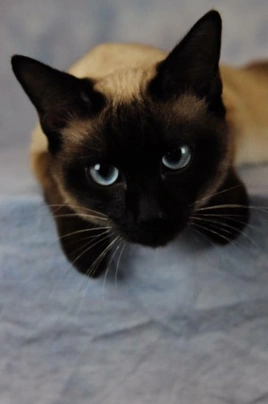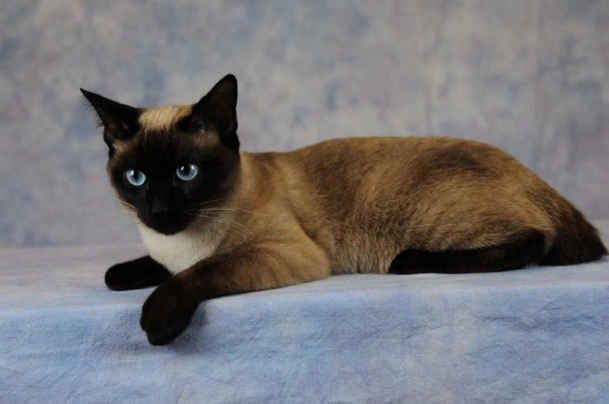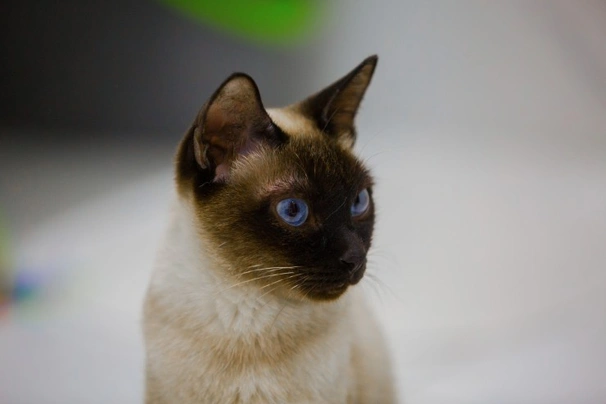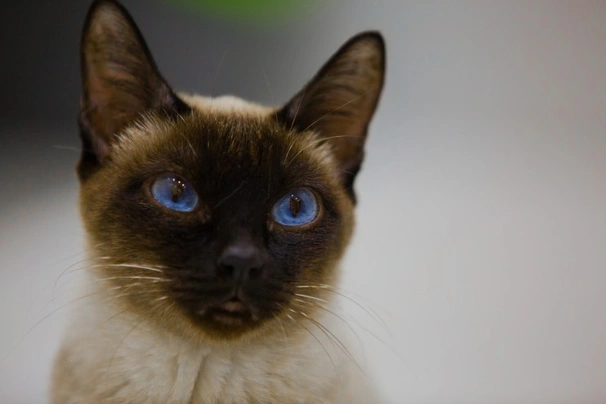Toybob
Introduction of the Toybob
Toybobs are often called the “smallest” of all cat breeds and are known for their loving affectionate natures. They are intelligent and love the company of their owners and being around other pets. They remain very kitten-like right through to their golden years and mature Toybobs never get any bigger than kittens of other cat breeds. However they are not “miniature” cats they are naturally small in size.
One of their most striking physical traits is their kinked short bobbed tails and unlike some other breeds this trait is not known to affect a Toybobs’ health or their agility. A Toybob can have a short or long coat and they come in an amazing amount of colours. These lovely little cats are not recognised by the GCCF as yet but they are recognised by TICA.
History of the Toybob
Toybobs are native to Russia to the Ural and Rostov regions of the country where the breed was developed. They have a long and fascinating history and heritage which all began in 1983 when a breeder of Thai Bobs took in a stray cat that resembled an “old style” Siamese. The stray’s tail however was short with several kinks in it.
The breeder bred the stray cat with a female short-tail seal-point which is thought to have been a “non-standard” Thai and the result produced a male kitten with an unusually short bobbed tail which the breeder named “Kutciy”. The kitten was to become the foundation cat of the breed.
By the early 1990’s the Toybob as a breed was registered as “Skif-Thai-Don” (Skif-Thai-Toy-Don) with 2 Russian cat breed associations but it was a four years later in 1994 that a WCF judge and author called Dr Olga S. Mironova renamed the breed “Toybobs”.
A breeder called Alexis Abramchuk who owned the Si-Savat cattery continued to develop the breed in the late 1990’s by outcrossing to other domestic cat breeds with a end goal being to increase the breed’s gene pool. However during the next ten years Toybobs were hard to find in their native Russia but thanks to the efforts and dedication of a Ural-based breeder by the name of Natalia Fedyaeva who owned the Little Angel cattery the breed was revived. She outcrossed to domestic cats that boasted the same phenotype and as well as other cats of the same “type”. To distinguish her Toybobs from those bred in the Rostov region of the country she added the prefix “Scyth” to her Toybobs and began showing them in the Unrecognised Breed category at the World Cat Federation shows.
The first Toybobs bred in the Ural region of Russia were imported to the US by a Burmese breeder in 2004 and four years later in 2008 the breed was awarded “Experimental” status with The International Cat Association (TICA) registered as the “Toybob” using the Ural breeding programmes and accepting “all colours and patterns”.
By 2014 most catteries that were registered with TICA started working together to develop the breed and formed the “International Toybob Cat Club” with an end goal being to gain full TICA recognition and to further the chance of breed recognition with other international cat associations although during the mid-2010’s Toybobs had already been granted full “Championship” status with cat associations in their native Russia. It was during this time that the “Rostov” bred Toybobs with the Skif prefix were being bred to a more “extreme” type than cats bred in the Urals that retained more of their phenotype traits.
In 2016 genetic testing was carried out on the breed by a geneticist by the name of Dr Leslie A. Lyons and a year later in 2017 the breed was accepted by TICA for “Registration Only” but were registered as a “Provisional New Breed” with another breed association based in the United States. In 2018 the Toybob was awarded Championship Status in North America in the CFF (Cat Fanciers Federation).
Interesting facts about the breed
- Is the Toybob a rare breed? No although finding well-bred kittens in the UK can prove challenging and as such they can often command a lot of money
- The breed was first developed in Russia in both the Ural and Rostov regions of the country
- One distinctive physical trait of Toybobs is that their tails are short and bobbed with several kinks in them which is a trait seen in certain feral Russian cats and which is a spontaneous mutation
- Adult Toybobs are as big as a kitten that’s 3 to 6 months old
- Toybobs are often described as being the smallest of all cat breeds
- Breeding programmes now exists in many countries of the world which includes the UK United States Japan Canada Denmark Bulgaria and Sweden
- Breeders can outcross Toybobs to both a Russian Domestic Shorthair and the Longhair that boast a similar phenotype which is permissible to develop the breed to establish a genetic “type”
Appearance of the Toybob
Ideal weight: Males 0.45 – 2.72 kg Females 0.45 – 2.72 kg
The Toybob is thought to be the smallest of all breeds with mature adult cats only growing to the size of kitten of another breed aged 3 to 6 months old. With this said they are nicely proportioned cats with moderate muscle tone and good bone structure. The most striking physical trait other than the Toybob’s small size is their short bobbed kinked tail which is a result of a spontaneous natural mutation they inherit from the Russian feral cats they have in their ancestry. Longhair Toybobs have the abbreviation TBL which indicates their coats are semi-longhaired.
A Toybobs’ head is a modified wedge of medium size with nice rounded contours and flat plane found above their eyebrows. Their heads are a little longer than they are broad with cats having nice rounded cheekbones that curve inwards from their faces to their mid muzzles which gives the impression of cats having slight or no whisker pinch making their muzzles appear a to be a modified square shape with adult male Toybobs having more prominent jowls. Their noses are Roman.
When seen in profile Toybobs have a distinct cure which starts with a dip at the forehead to a cat’s nose at middle eye level. Their chins are strong with a moderate depth and should never recede or protrude. Necks are thick and short with kittens having longer necks when young.
They have moderately tall ears which tilt a little forward which are set high on a cat’s head being wide at the base and with rounded tips. Their eyes are large expressive oval shaped and slightly slanting upwards with the line across the corners leading to the outer edge of a Toybobs’ ear. When it comes to eye colour this should correspond to a cat’s coat colour with pointed cats having blue eyes sepia cats having gold/green eyes and mink coated Toybobs having blue/green eyes.
A Toybob has a small compact body is nicely muscled with cats having a solid chest broad rib cage with a slight depth to their flanks which adds to their compact appearance and overall balanced appearance. They have virtually straight backs when they are seen from the side when walking naturally. Legs are strong being moderately in proportion with their bodies. A Toybobs back legs are a little longer than their front ones. Their feet are round with cats having elongated toes on their back legs.
A Toybob’s tail is bobbed with kinks and curves in it being a minimum length of 2 vertebrae and the maximum being down to a cat’s hock with the last bone being pointed but never blunt.
When it comes to their coat the Toybob can be shorthair or longhair. Shorthair cats have soft plush dense coats which are not close lying with undercoats being as long as their outer coats. The hair on their stomachs is shorter and softer but the texture of their coats along the spine is slightly coarser and thicker. Kittens often have coats that are slightly woolly.
TBL Toybobs have semi-long coats that are softer to the touch than their shorthair counterparts with their undercoats being of a similar length to their outercoats which gives the impression of cats having a plush appearance. Cats can have minimal ruffs over their entire bodies with noticeable ear furnishings but no ear tufts. Some pointed coat Toybobs can have white spots on their feet which is permissible.
When it comes to coat colours all colours are permissible in the breed**.**
Faults
Toybobs must not have definite stops.
Temperament of the Toybob
Toybobs are as their name suggest are small affectionate cats which have earned the reputation for being wonderful companions and family pets. They are active playful by nature without being hyperactive and overly demanding like some other breeds. With this said Toybobs do like their home comforts and enjoy being with their owners as much as possible.
Toybobs like a lot of cats like to be up high so they can watch the world go by from a preferred vantage point. They are incredibly agile and light on their feet and they like nothing more than to follow an owner from room to room so they can keep an eye on what they are doing.
Being so intelligent Toybobs learn new things quickly and they remain very kitten-like well into their senior years. With this said they never like being left to their own devices for any length of time which means they are better suited to households where there other pets or another Toybob so they always have company around.
Are they a good choice for first time owners?
Toybobs are a great choice for first time cat owners because they are so amenable and people-oriented by nature loving nothing more than to please and to entertain with this playful antics. They are especially good around children and older people too and have become extremely popular companions for the elderly.
What about playfulness?
Toybobs are known to have an extremely playful side to their natures which they retain well into their golden years. They enjoy playing interactive games with anyone who wants to play with them including the children in a household.
What about adaptability?
Toybobs are highly adaptable by nature and providing they are given lots of attention and things to do they are just as happy being kept as indoor pets as they are when they are allowed to explore the great outdoors bearing in mind that cats should only be allowed to go outside if it is safe for them to do so.
What about separation anxiety?
Toybobs are incredibly social and they enjoy company which means they are never happy when they find themselves on their own. They are much better suited to families where one person stays at home when everyone else is out or in households where there are other pets whether a dog or another cat.
Are they vocal?
Although extremely playful by nature Toybobs are not vocal and will seldom voice an opinion about anything except maybe at mealtimes.
Do Toybobs like water?
Like other breeds Toybobs love playing with a dripping tap but are not overly fond of getting wet.
Do they get on with dogs?
Toybobs love having company and get on well with dogs they have grown up with. They form strong bonds with their canine companions. However care must always be taken when a Toybob meets a dog they don’t already know just in case the dog does not get on with cats.
Intelligence / Trainability of the Toybob
Toybobs are known to be highly intelligent and they learn new things very quickly. Because they are so valuable it’s best to keep a Toybob as an indoor cat unless it is safe for them to venture outside without the risk of being stolen or involved in a road traffic accident.
Children and other
Toybobs with their outgoing affectionate personalities are a good choice for families with children. They are quick and agile on their feet and therefore know when to get out of the reach of smaller children when they get too boisterous or loud. However care has to be taken when very young children are around cats and any interaction should always be well supervised by an adult to make sure things stay nice and calm. With this said children need to be taught how to behave around cats and when it's time to leave them alone.
They also get on well with dogs especially if they have grown up together in the same household. Being so gregarious Toybobs enjoy the company of other animals and much prefer being around them rather than being left on their own. However care must be taken when introducing a Toybobs to dogs they don't already know just in case the dog does not get on with their feline counterparts.
Health of the Toybob
The average life expectancy of a Toybob is between 14 and 15+ years when properly cared for and fed an appropriate good quality diet to suit their ages.
The Toybob is known to be a healthy breed and one that does not appear to suffer from some of the hereditary and congenital disorders that many other breeds are predisposed to inheriting.
Caring for the Toybob
Toybobs enjoy being brushed on a regular basis because they love the attention and it helps keep their coats and skin are kept in top condition. They also need to be fed good quality food that meets all their nutritional needs throughout their lives which is especially true of kittens and older cats.
Caring for a Toybob kitten
Toybob kittens should be 12 weeks old when they are rehomed and they should have been given 2 vaccinations against Cat Flu and Feline Infectious Enteritis. These are normally done when kittens are 9 weeks and 12 weeks old. Responsible breeders always give new owners a diet sheet for kittens which details how often and what kittens should be fed and it’s crucial for new owners to follow the schedule to avoid any tummy upsets.
All kittens must be given enough time to get used to new surroundings so they are not overwhelmed by things. They should have a “safe” place they can retreat to when they want to take a nap. As such it’s always a good idea to restrict a kitten’s movement around the home and to keep them in one room until they gain more confidence in their new surroundings. Children must be taught how to behave around a small kitten and when to leave them alone.
Toybob kittens are very inquisitive and they often get themselves in all sorts of trouble. As such it is really important to “kitten-proof” a home before they arrive bearing in mind that they are extra small cats even when fully adult. This means making sure they cannot get outside that washing machine doors and other white goods doors are always kept shut just in case a kitten decides to get inside to take a nap.
It’s important to keep litter trays clean because a kitten may refuse to use it if it is dirty which could result in them going to the toilet elsewhere in the home. It’s also a good idea to use a natural cat litter and not one that clumps because kittens have a tendency to eat things they should not which includes cat litter. A clumping litter could end up causing a blockage in a kitten’s digestive tract.
Toybobs should be neutered and spayed when they are 6 months old and never before unless a vet recommends carrying out the procedure for medical reasons. Kittens should not be allowed to roam the great outdoors until they have been fully vaccinated against Feline Leukaemia Virus (FeLV) and Feline Immunodeficiency Virus (FIV).
What about when they reach their senior years?
As with any other breed Toybobs like being brushed on a regular basis which also helps keep their coats and skin are kept in top condition. On top of this they need to be fed good quality food that meets all their nutritional needs throughout their lives which is especially true of kittens and older cats.
Grooming of the Toybob
A Toybob can have a short close lying coat or a semi-long coat. Shorter haired cats need less in the way of grooming than their longer coated counterparts. A weekly brush and wipe over with a chamois leather is all it takes to keep their coats in good condition with a nice sheen on it. Like other breeds they tend to shed the most in the Spring and then again in the Autumn when more frequent brushing is usually necessary to keep on top of things.
It's also important to check a cat's ears on a regular basis and to clean them when necessary. If too much wax is allowed to build up it can lead to a painful infection which can be hard to clear up. In short prevention is often easier than cure with ear infections. Cats often suffer from ear mites which is another reason why it's so important to check their ears every week or so.
Exercise of the Toybob
The Toybob is a high energy playful intelligent cat and one that likes to be given a tremendous amount of stimulation for them to be truly happy. Most owners tend to keep their pets as indoor cats because being so valuable a Toybob runs the risk of not only getting injured but stolen too.
Cats kept as indoor pets need to be given lots of things to do and places to hide when they want to bearing in mind that a Toybob loves to climb up high so they can look down on the world below from a high vantage point. They also need to have lots of places they can snuggle up for a snooze when the mood takes them because if there is one thing cats are really good at it's taking lots of naps during the day.
Feeding of the Toybob
If you get a Toybob kitten from a breeder they would give you a feeding schedule and it's important to stick to the same routine feeding the same kitten food to avoid any tummy upsets. You can change a kitten's diet but this needs to be done very gradually always making sure they don't develop any digestive upsets and if they do it's best to put them back on their original diet and to discuss things with the vet before attempting to change it again.
Older cats are not known to be fussy eaters but this does not mean they can be given a lower quality diet. It's best to feed a mature cat several times a day making sure it's good quality food that meets all their nutritional requirements which is especially important as cats get older. It's also essential to keep an eye on a cat's weight because if they start to put on too much it can have a serious impact on their overall health and wellbeing. Like all other breeds a Toybob needs access to fresh clean water at all times.
Feeding guide for a Toybob Kitten
As a rough guide a Toybob kitten should be fed the following amounts in any 24 hour period making sure they are fed little and often:
- 2 to 3 months – 10g/30g kibble or 5g/12g kibble mixed with 1 sachet of wet food depending on weight
- 4 to 6 months – 16g/35g kibble or 8g/18g kibble mixed with 1 sachet wet food
- 7 to 9 months – 20g/40g kibble or 13g/22g kibble mixed with 1 sachet wet food
- 10 to 12 months – 22g/42g kibble or 18g/23g kibble mixed with 1 sachet wet food
Feeding guide for an adult Toybob
Adult Toybob should be fed a good quality diet to suit their ages. As a rough guide an mature cat should be fed the following amounts in any 24 hour period:
- Cats weighing 0.45 kg to 6 kg can be fed 8g/35g of kibble or 5g/15g of kibble mixed with 1 sachet of wet food depending on age and activity
Toybob price
If you are looking to buy a Toybob you would need to pay upwards of £900 for a healthy responsibly-bred kitten and you would need to register your interest with breeders and agree to being put on a waiting list because very few Toybob kittens are produced every year. The cost of insuring a male 3-year-old Toybob in northern England would be £22.85 a month for basic cover but for a lifetime policy this would set you back £31.89 a month (quote as of September 2018). When insurance companies calculate a pet's premium they factor in several things which includes where you live in the UK a cat's age and whether or not they have been neutered or spayed among other things.
When it comes to food costs you need to buy the best quality food whether wet or dry making sure it suits the different stages of a cat’s life. This would set you back between £15 - £20 a month. On top of this you need to factor in veterinary costs if you want to share your home with a Toybob and this includes their initial vaccinations their annual boosters the cost of neutering or spaying a cat when the time is right and their yearly health checks all of which quickly adds up to over £500 a year.
As a rough guide the average cost to keep and care for a Toybob would be between £35 to £55 a month depending on the level of insurance cover you opt to buy for your cat but this does not include the initial cost of buying a healthy well-bred Toybob kitten.



